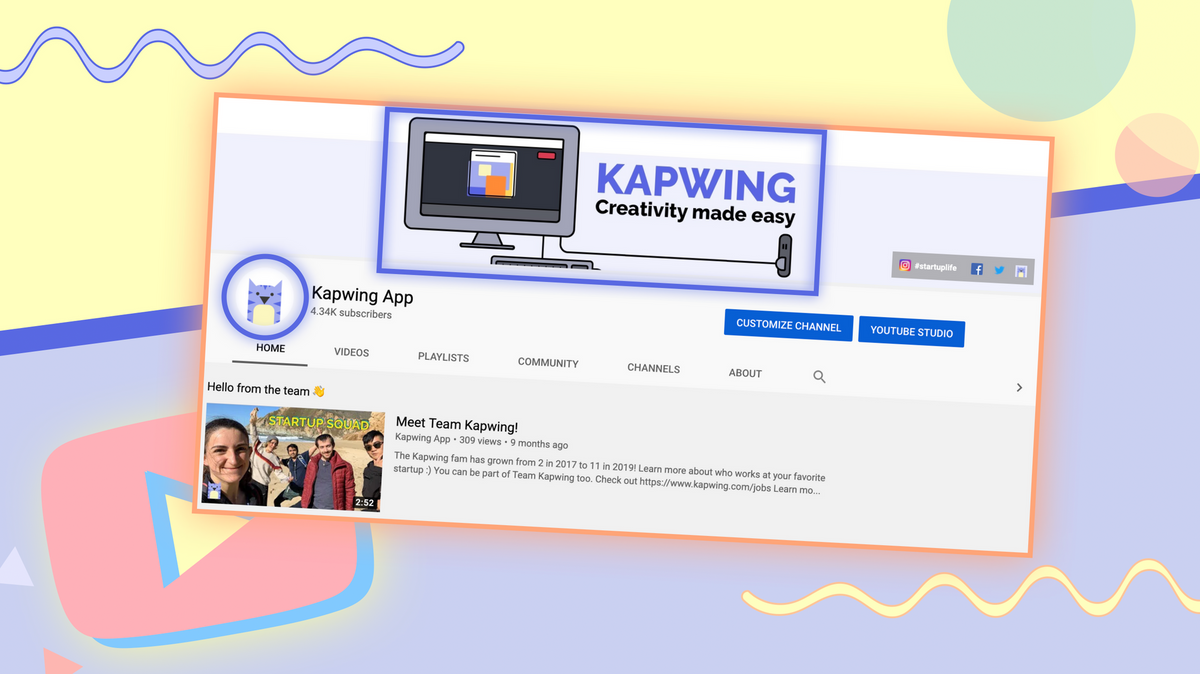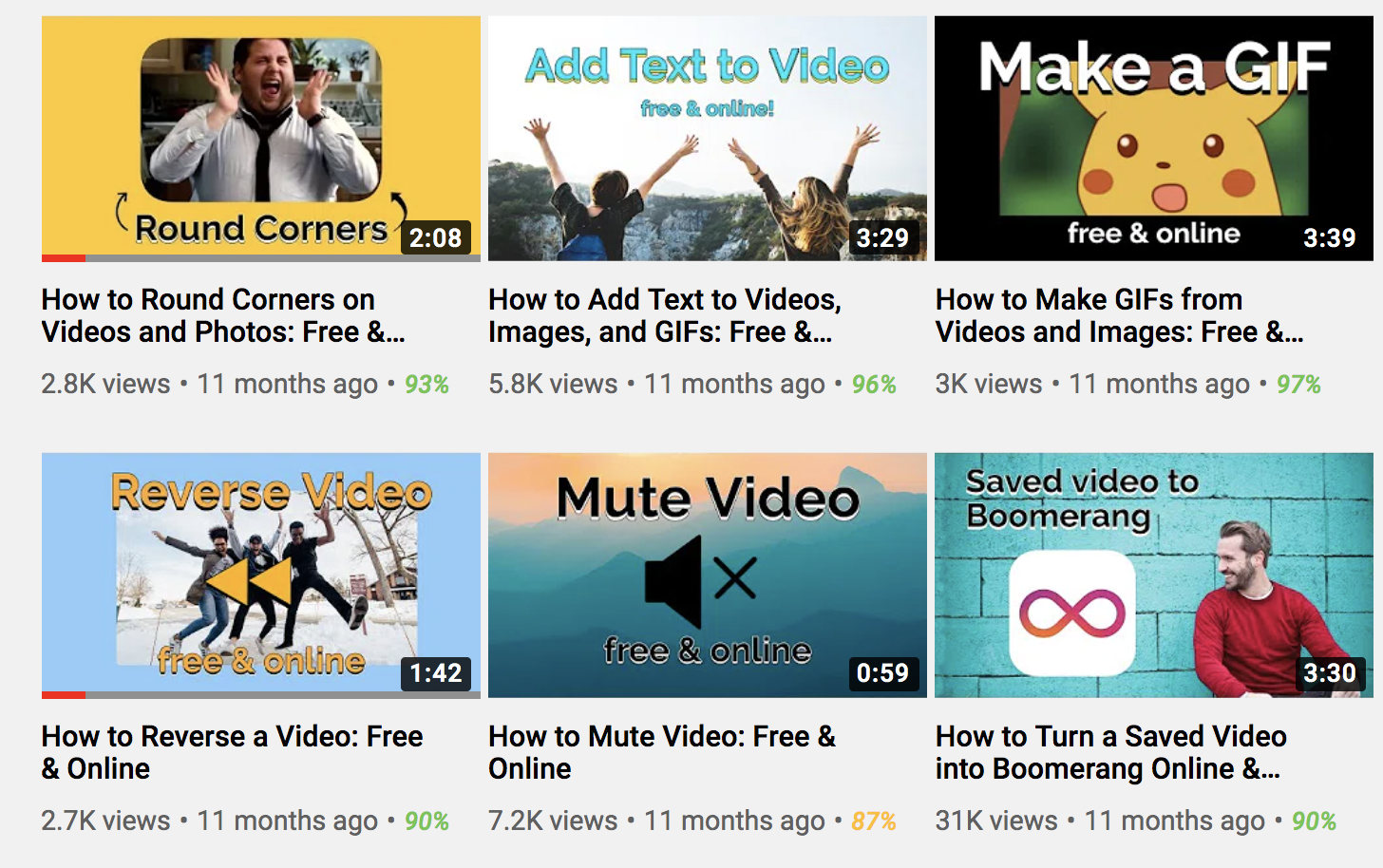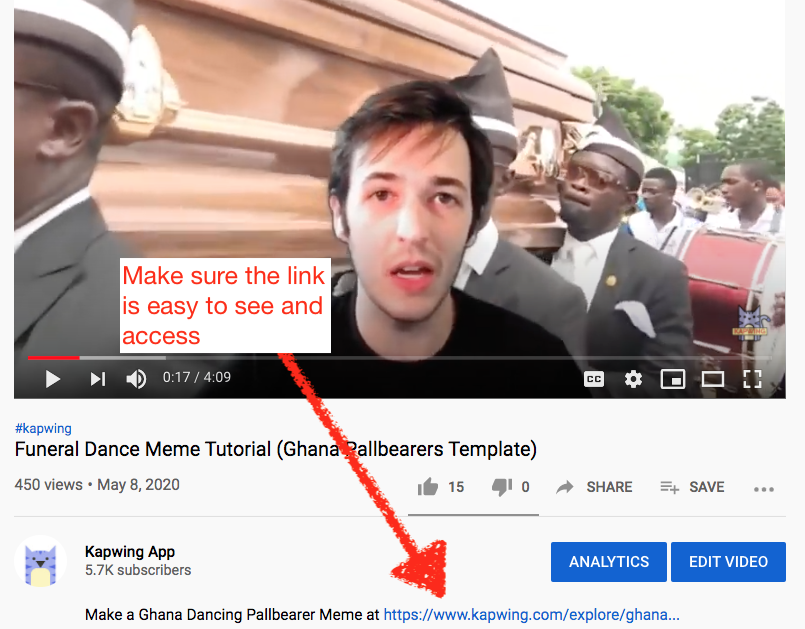How to Grow a SaaS Startup on YouTube: Learnings from Year 1
How does a startup get to their first 1000 YouTube subscribers and leverage YouTube to grow a SaaS business? In this article, I share our journey for other founders considering YouTube as an organic growth channel for their startup.

Note: I wrote this article in December 2019. Now (in July 2020) the Kapwing YouTube channel has grown to about 8k subscribers, largely through the same tactics described below. I’m sharing this article now because, with so many people online during covid-19 lockdowns and shelter in place, many of Kapwing’s creators are exploring Youtube as an organic distribution channel for their business or as a personal side project. Hopefully this article helps people get traction on YouTube for the first time.
Check out our follow up post on how we go to nearly 200,000 subscribers.
Two years ago, my cofounder and I started Kapwing, a website for creating/editing images and videos. We've grown the website to millions of monthly-active visitors through purely organic means: SEO, content marketing, and social media.
Starting in June 2019, we started investigating YouTube as a distribution channel. In four months, we grew our company YouTube channel to nearly 2000 subscribers while spending no money on video production or promotion. Now, one year later, we have 7900 subscribers and hundreds of thousands of new users referred to our website through YouTube. Our videos have >240,000 views each month, and our referral traffic grew more than 4x in Q2 2020.

For founders just getting started on YouTube, I wanted to share my learnings and experience with it as a small business owner. In this article, I’ll describe how we grew our YouTube subscriber base and the impact it’s had on our SaaS business. I’ll also give practical tips for other SaaS entrepreneurs who are interested in using YouTube as a distribution channel.
Why Invest in YouTube?
SEO accounted for 85% of our early growth, and YouTube is similar to Google Search. Our product is an online video editor, so we suspected that YouTube was an important place for people learning to make YouTube videos for the first time. But neither of us had ever made YouTube videos for work, and we couldn’t afford to pay an agency to run the channel for us. We opted to take a scrappy approach instead.
Initial Research from other SaaS Companies
Before we started on the YouTube journey, we investigated what other SaaS companies do for their YouTube channels. Successful SaaS companies are somewhat polarized when it comes to YouTube. Companies like Invision, Figma, and Twilio have invested a lot in YouTube with thousands of videos and tens of thousands of subscribers. Others, like Carta and Affirm, have fewer than 200 subscribers and have only uploaded a handful of videos.
Our own research found that other SaaS companies were publishing the following types of videos on their channels:
- Recruiting or culture videos that showcase employee life and office culture
- Produce Demos and Announcements that introduce or teach how to use new features and capabilities in the product
- Onboarding Videos that show viewers how to set up the product for the first time
- Webinars and Recordings of speeches, panels, and talks from company events (AppDynamics Example)
- Customer Testimonials about how the software adds value from a credible user
- Advertisements that were made-for-TV or YouTube campaigns (Gusto example)
- Expert Advice on topics related to the core problem that the product addresses
How We Reached 1600 Subscribers
Step 1: Just Get Started

In early 2019, I set up our YouTube channel with a shared company Gmail account. We started out with very simple screencasts, videos I literally recorded while sitting in bed at home.
At that point, Kapwing wasn’t very sophisticated, so the videos didn’t have many edits. Our videos showed Kapwing’s basic features and walked the user through basic tasks. I experimented with tactics to produce these videos quickly:
- Filmed videos in a single-take videos.
- As quick and brief as possible. Didn’t write a script. I did one practice run before filming and improvised.
- Spoke loudly and clearly into the microphone. Audio quality matters more than video quality.
The impact of these videos was SMALL. We didn’t get many subscribers or new users, but a few of those early uploads have gained significant traction over time. They also gave us a baseline to set expectations and improve. Only one of those initial videos is still in the top 10.
Takeaway: A YouTube journey starts with a single video; stop making excuses and just get started.
Step 2: Higher Quality Uploads
Tara, our first operations hire, had experience with graphic design and animation and wanted to get involved with our YouTube channel. She started out by upleveling the overall polish of our channel page. She created playlists for our videos, added a YouTube banner image that upgraded the visual brand of our channel, and designed a reusable thumbnail template and title animation that we started using across all of our videos.

This introduced visual consistency and making the channel look more professional and cohesive. Her videos had more personality, narrative, and were generally more entertaining. But these uploads also took much longer to film, edit, and publish. She could only publish one a week or so.
The Impact of Tara’s videos on our channel was LARGE over a long time, but small in the short-run. It can take several months for a video to truly find its audience. The gradual effects of SEO make it difficult to predict success out of the gate. Six months after they were uploaded, Tara’s videos gained more than 100k views (nearly half of all our impressions). But it was hard to tell at the time if our videos were working or not.
Takeaway: Kapwing’s videos were getting better, but our channel still wasn’t gaining many new subscribers. Quality doesn’t immediately lead to channel growth. In fact, some of my favorite videos (like the one below) didn’t get much traction at all.
Step 3: The Vlog Experiment
On Kapwing’s blog, stories about the journey of growing our startup have brought a lot of new viewers to our website. We wanted to experiment with a similar strategy on YouTube, sharing vlog style videos about the entrepreneurial journey of growing Kapwing. In Summer 2019, we hired Grace Windheim, a Johns Hopkins senior and small YouTuber to join our team as an intern solely focused on YouTube.
Grace dove right in with an excellent 11-minute video about postering San Francisco. Despite the large amount of effort and planning that went into this video, the upload failed to attract many new viewers or subscribers. In the six months since Grace published the video, it’s been viewed fewer than 200 times.
Grace tried many types of videos throughout the summer: 73 Questions with a Startup CEO, customer testimonials, day-in-the-life, and a nice channel intro. We published demos, videos in partnership with our creators, giveaways, music videos, and even memes. These higher-effort videos took longer (often more than 1 week) to film and edit, and they set a high standard for production quality on our channel.
The impact of the vlog experiment was SMALL.These videos were entertaining and extremely on-brand, but they didn’t attract new viewers and weren’t showing up in searches. With a small subscriber count, no one discovered or watched the entertaining content we were publishing. As a result, our subscriber count remained stagnant despite our heavy time investment.
Takeaway: The Startup Stories are a lot of fun and great for team morale, but they don’t drive growth. Less than one percent of our total YouTube views come from what are arguably our most entertaining videos. To keep growing our channel, we realized we’d need to stick to content that has a high probability of showing up in search results.
Step 4: Large Influencer Shoutout
Then, something completely out of our control happened: a major YouTuber made a video about Kapwing. GaMemeNeer is like the Dutch version of Pewdiepie; he uploads meme reviews and gaming videos for an audience of over 1 million subscribers. One day in July 2019, he published a YouTube video hating on Kapwing because so many meme submissions from his followers had our company's watermark. He told his audience to stop using Kapwing because he hated seeing our logo.
We were thrilled. The upload was amazing exposure for our brand; a video with “Kapwing” in the title got more than 200,000 views in its first week. The timing also happened to be perfect. We had just closed our Series A and were planning to make it free for users to remove the Kapwing watermark. It would look as if we made this change in response to GaMemeNeer’s video.
Grace and I decided to send GaMemeNeer - whose real name is Don - a selfie-style video explaining our move to remove the watermark. Don was incredibly kind and immediately replied with words of encouragement about our company. Two weeks later, he published a follow-up video that featured the video we had sent him and told all of his followers they should go use Kapwing again. Like clockwork, another 200,000 viewers watched his video.
The impact of our parlay with GaMemeNeer was LARGE. Our subscriber count immediately climbed. Gamemeneer is a major influencer and the shoutout affected our subscriber base more than any other growth initiative or event.
Takeaway: Forming relationships with big creators and getting those much sought after shoutouts is well-worth the time and energy. Many YouTubers won’t respond or will put a hefty price tag on shoutouts, but if you can find a way to get their attention, the reward can be significant.
Step 5: Search Optimized Tutorials
Halfway through the summer, our intern Grace shifted from a high-quality to high-quantity mindset and came up with a plan for how she could churn out videos and grow our subscriber count. For topic ideas, she tried using YouTube SEO tools like VidIQ and used our Resources library as a source of inspiration. Her more successful videos targeted niche, direct tasks like “Make Heart Emoji Meme,”“How to Make a To Be Continued Meme,” and others.

Grace soon went from making 1 video in 10 days to making 10 videos in 1 day. The uploads were extremely simple with few post-production edits, similar to the ones I had made on my own in the early days.
We also started a more focused effort to increase our subscriber count by promoting our YouTube channel on our other web properties. We added the YouTube channel to our website footer, About Us page, and blog. We pushed our channel on Twitter and Facebook. We encouraged viewers to subscribe and put a ‘Subscribe’ button in the corner of every video.

We also always link to Kapwing from the first line of the YouTube description, meaning our website is "above the fold."

The impact of our quantity over quality approach was LARGE. The combination of Gamemeneer’s shoutout, subscriber growth efforts, and Kapwing’s expanding brand equity led our subscriber count to grow steadily over time. It was little-by-little growth, not all at once.We had 800 subscribers by September, 1000 subscribers by mid-October, and 1500 by November. These basic screencast tutorials (from step 1 and 5) represent more than 80% of our total Youtube views.
Today, more than 50% of our YouTube views come from Google Search. 25% come through YouTube search. As we’ve grown, more and more of our traffic has come from other sources (suggested, Youtube search, etc), but Google Search is still the largest source of traffic by far.
Takeaway: Don’t underestimate the value of Google Search. Make videos that target stuff people are searching for online to grow an audience.
How We Make Our YouTube Videos
All of the videos were edited using Kapwing’s YouTube video editor. We generally combine four types of video clips to make a tutorial-style video:
- Intro: Selfie video describing what you’re going to demonstrate
- Title: An animated slide that has the title of the video
- Demo: Screencast with face in corner showing how to complete the task at hand (often filmed using Loom)
- Outro: Selfie video thanking the viewer and asking them to Subscribe.
We add music using the Add Music tool, insert sound effects with the Timeline, animate images and text, and add our custom branded subscribe button.
Check out our YouTube Resources library for more tutorials and stories about setting up your YouTube channel.
Conclusion
My high-level advice for any creator getting started on YouTube is to focus on practical questions that people might search for and give speedy, informative answers. Growing a lifestyle video channel or a multi-video series is much harder because your content is less discoverable on search.
If you're just getting started and don't have an existing audience, pick an area that you have good advice on and start making content. Use titles, descriptions, and keywords that someone might actually type into YouTube so that they find your videos. Even if your content has low production value, you will gain viewers and subscribers over time through the magic of Google Search.
Thanks for reading! Sign up for our mailing list below to get more advice and insider stories about growing a SaaS startup in Silicon Valley. I hope that this article helps other media entrepreneurs and business owners get their first 1000 followers on YouTube, even while working remotely.






